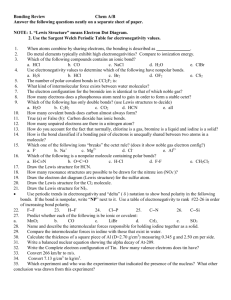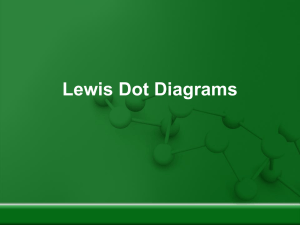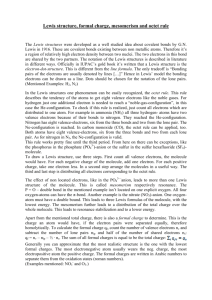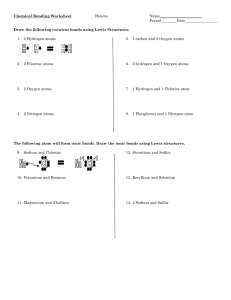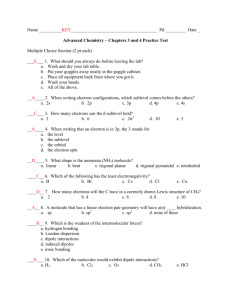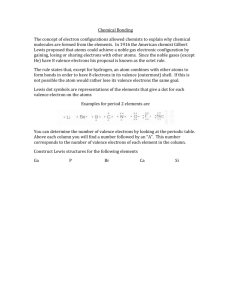Chemistry Presentation: Nomenclature, Lewis Structures, Polarity
advertisement
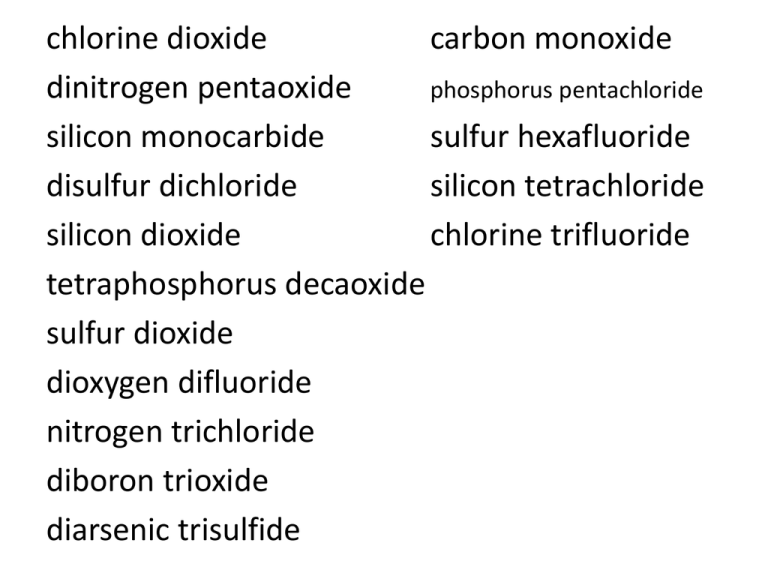
chlorine dioxide carbon monoxide dinitrogen pentaoxide phosphorus pentachloride silicon monocarbide sulfur hexafluoride disulfur dichloride silicon tetrachloride silicon dioxide chlorine trifluoride tetraphosphorus decaoxide sulfur dioxide dioxygen difluoride nitrogen trichloride diboron trioxide diarsenic trisulfide chlorine monoxide beryllium oxide phosphorus triiodide zinc oxide nitrogen dioxide nitrogen tin(IV) cyanide dichlorine monoxide nitrogen trifluoride dichlorine octaoxide sulfur trioxide oxygen difluoride carbon tetrachloride potassium permanganate trisilicon tetranitride phosphorus pentabromide dinitrogen monoxide TODAY: read page 37 and pages 164167 Diatomic molecules Lewis Dot Diagrams for Molecules HW: Worksheet – Lewis Structure exercises Retest: Monday Feb. 4 Quiz: Thursday or Fri Feb. 7 or 8 ELECTRONEGATIVITY AND POLARITY • electronegativity = ability of an atom to attract electrons in a covalent bond • most electroneg. element = flourine • least electroneg. element = francium • Unequal sharing of electrons will produce a polar bond. ELECTRONEGATIVITY AND POLARITY • • • • F–F H–F H2O NH3 diatomic molecules: molecules with 2 atoms of the same element there are 7 – know them! N2 O2 H2 Cl2 I2 F2 Br2 or Br2 I2 N2 Cl2 H2 O2 F2 show the valence electrons as dots inner electrons and atomic nuclei are represented by the symbol group 1A: 1 valence e group 2A: 2 valence e-, etc. diatomic molecules 1. Count valence electrons and bonds using periodic table and octet rule – make a chart to get valence and shared electrons 2. Choose an arrangement of atoms (carbon in center, hydrogen or halogens on outside) 3. Put in calculated number of bonds; single bonds first, then multiple bonds if necessary. 4. Where necessary to complete octets, put in non-bonding electrons in pairs. 5. Check work by counting electrons in Lewis structure and comparing calculated number of valence electrons. LEWIS STRUCTURES CH2O C H H O V 4 1 1 6 12 lO S 4 H–C–H 1 1 2 8 / 2 = 4 bonds LEWIS STRUCTURES NH3 N H H H V 5 1 1 1 8 S H–N–H 3 H 1 1 1 6 / 2 = 3 bonds LEWIS STRUCTURES SO32– S O O O V 6 6 6 6 24 +2 26 S 2 2O–S–O 2 2 O 2 8 -2 6 / 2 = 3 bonds POLYATOMIC IONS FROM NOW ON: know NO CO SO PO ions (–ates and –ites) know NH4+ know –ides: cyanide, hydroxide know chlorine containing ions

